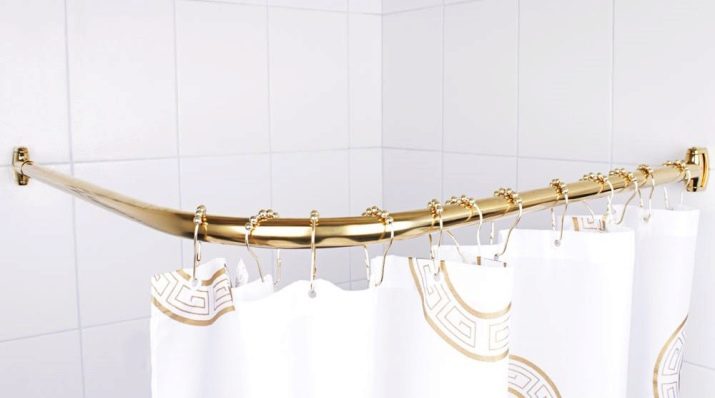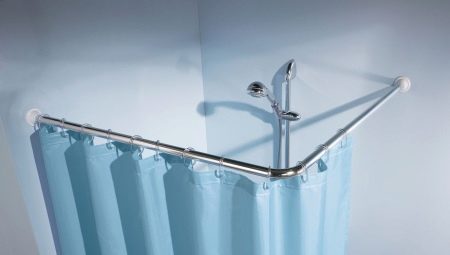A cornice is an architectural ledge that plays a specific engineering or design role. In the bathrooms, a special longitudinal bar serves to support the curtain, which serves to support the curtains. Depending on the characteristics of the interior of the room and the characteristics of the bathroom installation, the configuration of the cornice may vary in shape, profile, material and appearance. To achieve the highest operational efficiency when installing a bathroom cornice, you should focus on a list of its varieties.
The choice of the suitable one will be determined by the maximum combination of the totality of its parameters and the premises. In our article, we will talk about angular variations.
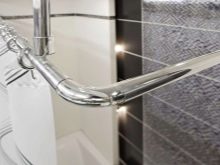
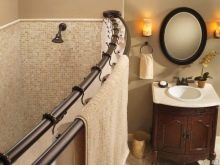
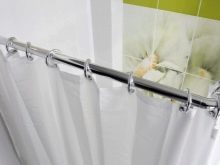
Kinds
The current market for bathroom accessories offers a wide selection of curtain rail modifications. The horizontal bar can be:
- radial;
- semicircular;
- l-shaped;
- straight.
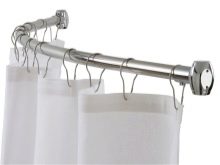
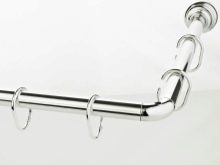
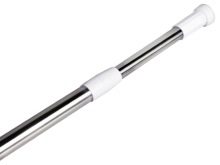
If in the bathroom the bathtub has a round profile and is installed in the center or at some distance from the nearest walls, it is advisable to use a radius cornice strip.
In this case, the curtain suspended on it will close the selected area around the perimeter, preventing moisture from entering beyond its borders. To install such a cornice, vertical racks are mounted, which are attached to the floor surface.
Depending on the purpose and design of the model, the number of racks and their location on the circle line may vary. In this case, the movement of the curtain in a circular direction cannot be continuous.The presence of racks prescribes a restriction on movement, which leads to the advisability of dividing the curtains into several parts or using separate ones, some of which are fixed in a static position, while others remain movable.
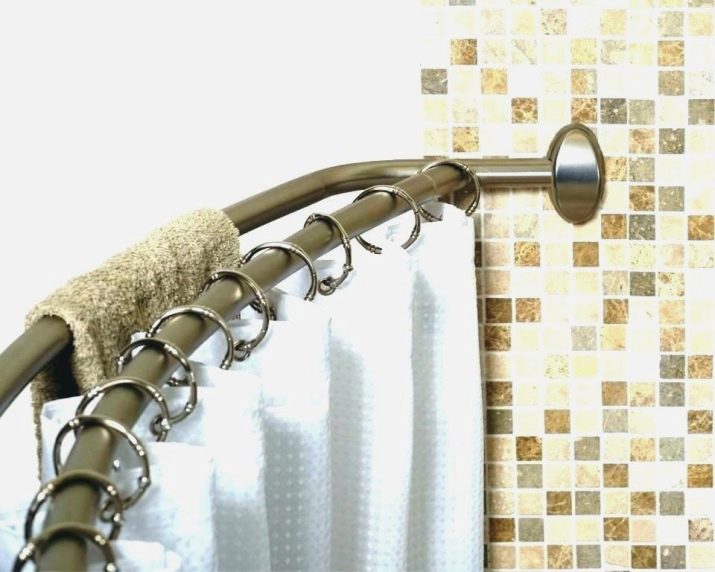
Semicircular plank The cornice is used in cases where the bathtub tray has an angular configuration of the inner side (adjacent to the wall) and a semicircular external shape. In this case, the points of support for the plank are two adjacent walls, and the direction of its axis repeat the outline of the outer part of the pallet.
The use of such a bar has a visual resemblance to a shower cabin. One or more curtains suspended on it resemble sliding boxing doors.
L-shaped arc - This is a modified analog semicircular. Their main difference is the presence of a right or an unfolded angle dividing the two parts of the bar. Its perimeters are repeated by the contour of the outer side of the bathroom tray, which in this case has a square or semi-square shape.
The length of the sides of the L-shaped cornice can be equal to or have a difference in lengths in a certain ratio. Due to this feature, this type of bar is one of the most common among users.
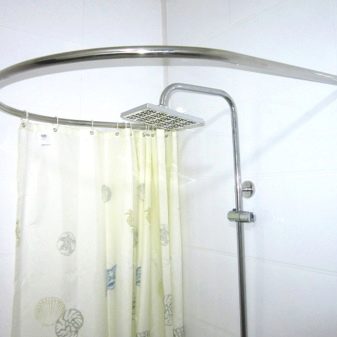
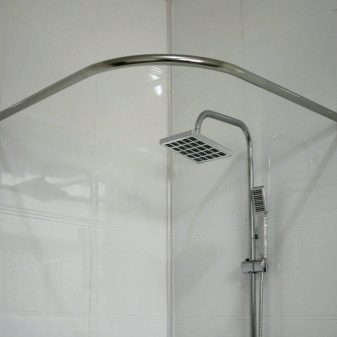
The direct cornice configuration is used in conjunction with standard form bathrooms. The external perimeter of such pallets is rectangular, which allows them to be installed along the wall or in a corner. Although some of them are made in the shape of an oval or irregularly shaped figures, a straight stick is ideal for isolating the wash area from spraying moisture outside.
The main criterion for choosing a cornice for a bath is its size. Depending on this value, the best fit of the profile, length and external characteristics is determined.
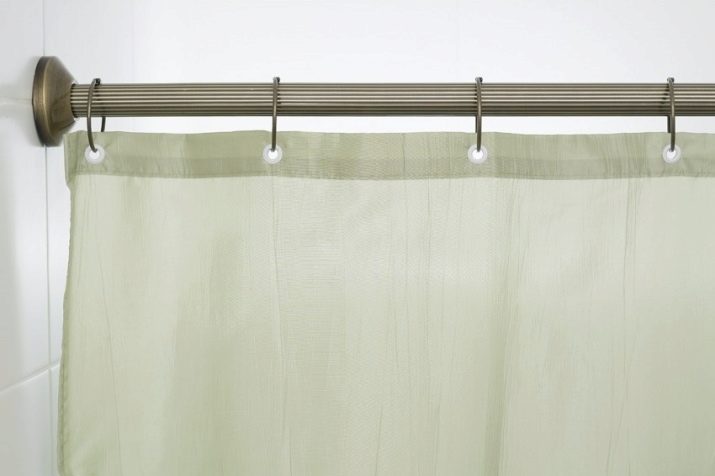
Dimensions
Among the wide range of sizes of shower curtains the main dimensional types can be noted:
- 120x70;
- 150x70;
- 170x70;
- 160x100;
- 90x90.
Modifications, the sizes of which correspond to the parameters of the first four items of the list, belong to the category of large-sized ones and are used in bathrooms having standard or oversized pallets.
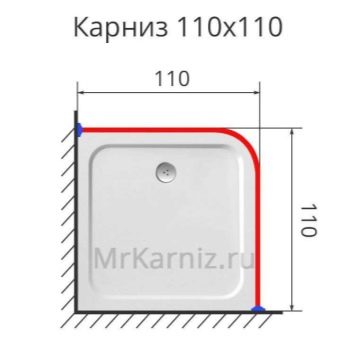
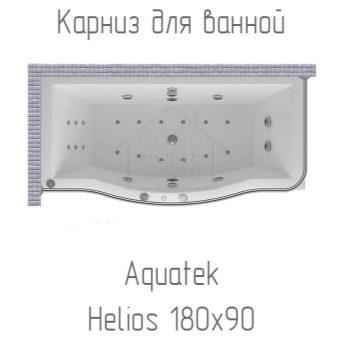
The type of the cornice strip at the end of the list has a non-standard size that differs from the general household. In most cases, such rods are used to hold the curtain that covers the bath pan, which is located in specialized premises. Such premises include those that are equipped in hotel rooms, motels, specials. train cars. The small size (in cases with similar rooms) is due to the need to save free space.
Among other things, the dimensions of the holder affect the choice of material from which to make it. The higher the indicator, the stronger the material should be.
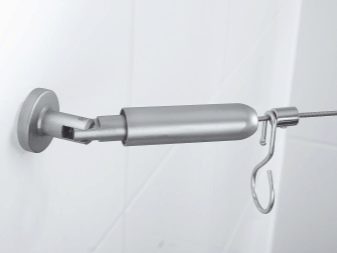

Materials
The most common materials used in the manufacture of the cornice are metal alloy and plastic. Planks made of pure iron are extremely rare. This is due to the increased value of their mass, which increases production costs and makes it inappropriate to use as intended - retention of a lightweight curtain.
Metal alloys
This type of material is an alloy of two or more light metals. These include aluminum, duralumin and others. In some cases, additional components are added to the composition of the main alloy, forming the totality of the specific characteristics of a noble metal. The final product is a cornice made in bronze, brass, gold or silver style.
A popular type of exterior finish for bathroom eaves is chrome plating. The surface of an object subjected to such processing is an imitation of metal polished to a mirror shine.In many cases, chromium plating prevents the development of corrosive processes that can impair the integrity of the rod material.
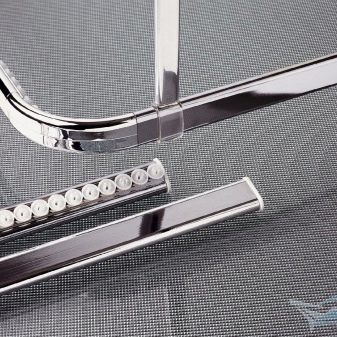
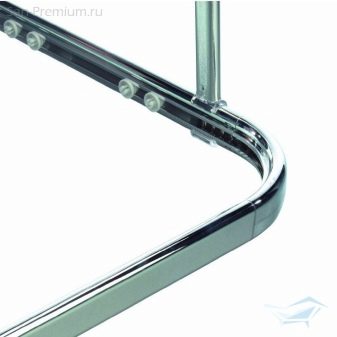
Plastic
Cornices made of plastic are budget modifications. Such they are made by a simplified production process and low cost of the main component - plastic. Their mass does not exceed critical values, which facilitates installation, but reduces the threshold of resistance to axial loads. Often, such strips require the installation of additional supports located at the points of greatest impact of the force vector directed downward.
Planks made of plastic and metal alloy are hollow. This reduces the level of useless mass of the product. To increase the strength, plastic ones can have internal jumpers - stiffeners that increase resistance to deformation loads.
A popular manufacturer selling such products is the Ikea brand.

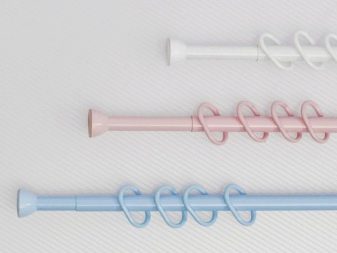
Manufacturers Overview
We present a list of collections, including corner cornices, from Ikea.
- Classic С090-3. Telescopic installation principle. Does not need additional fasteners. It is made of lightweight aluminum. Hanging rings for curtains are not included.
- Mr. Penguin KSS-01-04. The installation method is telescopic. The material of manufacture is durable plastic. There are anti-slip gaskets.
- Vanstore 673-10. It is made of lightweight metal alloy. The method of attachment requires additional fasteners.
- Tatkraft Mast 200. Telescopic curtain rod with plastic spacers.
- Forma Ultra. It is delivered in various profile modifications.
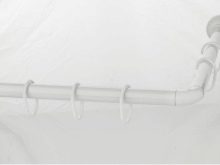
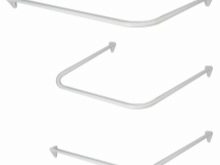

How to choose?
To choose a curtain rod for a bathroom, you need to decide on its purpose. Within this indicator, it can perform a number of functions, the name of which depends on the needs of the user.
Primary attention is drawn to the shape: it will be angular, straight, semicircular or radius cornice. Next, it is worth determining what type of curtain will be hung on it. Will the curtain material be heavy or light. It is also worth paying attention to the number of segments within which one or more curtains can move. Often, these segments are limited to the points of attachment of the supports, suspensions or rotations of the shape of the cornice.
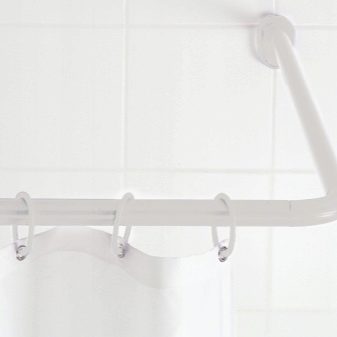
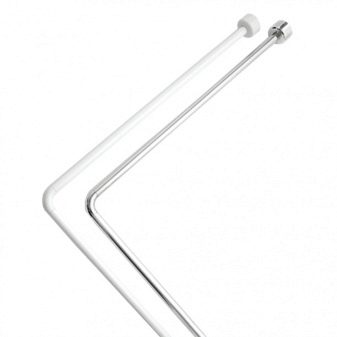
If a curtain with a set of hanging rings is already available, you should pay attention to their shape. They can be round, oval or rectangular with rounded corners. Depending on the shape of the rings, the cornice profile is also selected: round, oval or rectangular with rounded corners.
Bath rods are selected taking into account the design features of the room. The cover of the holder should correspond to the main direction of the color scheme of the interior elements.
If the bath supports are made in bronze tones of the classicism style, a good solution would be to choose a bar that reflects such visual characteristics. The same is true for other stylistic combinations.
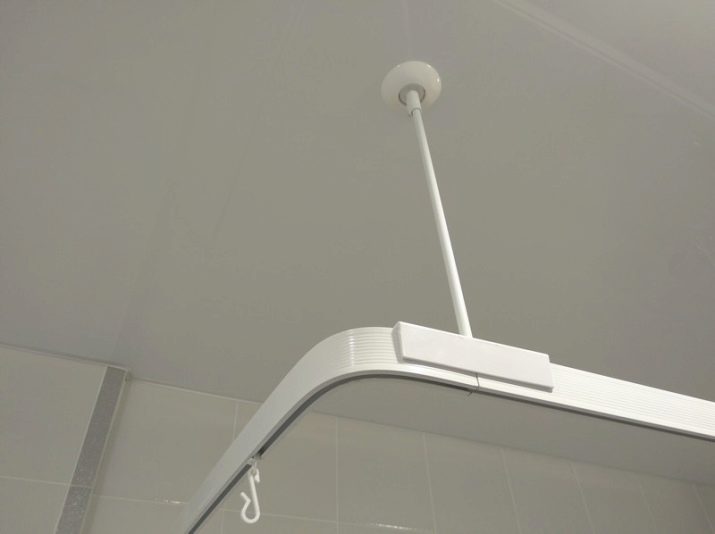
Installation Nuances
There are several ways to fix the bathroom cornice to the walls. The choice of method depends on the nature and condition of the wall surface, the operating conditions of the rod and the individual needs of the user.
Fixed Mount Method
This method is one of the most time-consuming and requires a greater amount of time, effort and money to implement. Moreover, it is the most reliable. The cornice attached in this way is more resistant to loads of various types, and its position remains unchanged for longer.
To install in this way you will need the following set of tools:
- electric hammer drill;
- a hammer;
- crosshead screwdriver;
- construction knife with interchangeable blades;
- extension;
- marking tools: pencil or marker;
- measuring devices: bubble level of the appropriate size, tape measure.
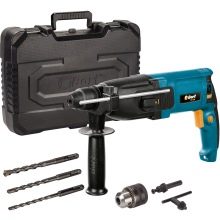
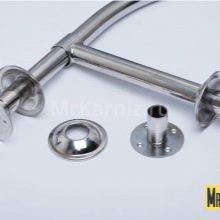
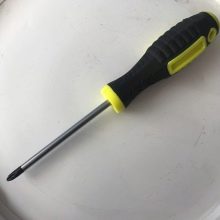
Expendable materials:
- masking tape;
- dowel nails.
A perforator is required for drilling holes into which dowels and nails will be inserted, designed to hold the cornice in a static position. When conducting drilling, you should make sure that the material of which the wall is made allows you to safely perform this type of work. If plasterboard is located under the facing surface, make sure that the mounting holes are at the level of the nearest transverse battens of the crate of the frame holding the gypsum board on the wall. This will increase the fastening strength and avoid the occurrence of destructive damage that may occur as a result of the break of the cornice due to the action of gravity on it.
Before drilling, it is recommended to stick pieces of masking tape in the area of contact between the boom and wall seats. This will make it possible to effectively carry out marking manipulations, since often marking is complicated due to the properties of the facing material covering the wall surface.

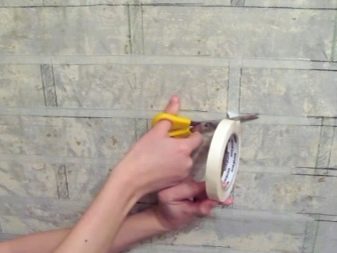
If the wall is covered with ceramic tiles, it is important to drill with special care so as not to damage the lining. After drilling, dowels are inserted into the holes. If they have persistent hats or some part protrudes above the wall surface, it is necessary to cut off the excess part of the dowel. The protrusion can worsen the contact of the seat plate with the wall. For a cut, it is better to use a construction knife with interchangeable blades, since they, when bent, perform a cut better.
Further, in accordance with the location of the holes, a cornice landing element is applied to the wall and secured with dowels. For their effective installation, you can use a Phillips screwdriver as a kind of chisel. This allows you to hammer a dowel-nails with a hammer, without damaging the surface of the landing element.
Then, the cornice tube is inserted into the corresponding hole in the landing part, which is then fixed by screwing in a side countersunk screw.
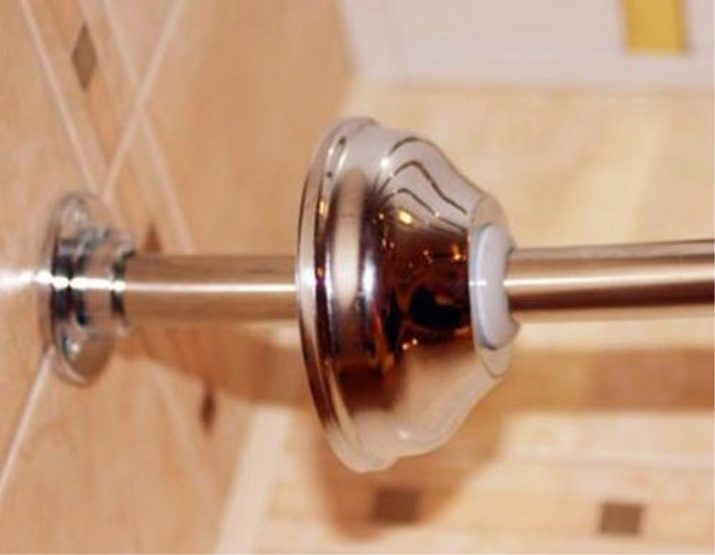
In this way, most varieties of trims for the bathroom are installed. If the manufacturer's instructions provide a different mounting method, you must follow it. To do this, you should carefully read the provisions of the manual that comes with the kit.
Other types of cornices are attached in a simplified manner. If the principle of operation of the device is telescopic, when the halves are extended, it abuts against two opposite walls. In other cases, when the possibility of sliding is not provided, the fasteners used are included in the kit, for example, special glue or reinforced double-sided tape. In order to attach it using these means, it is necessary to clean and degrease the contact surface.
Neglect of this manipulation may entail subsequent spontaneous dismantling of the device. In this case, the surface of the wall or the seat may be irreversibly damaged.
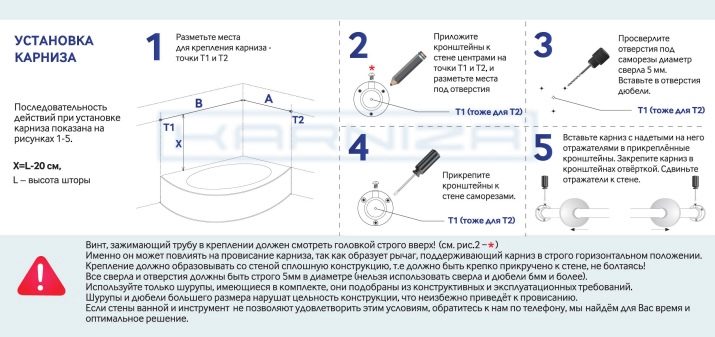
See below for how to install a bath eaves.
Examples in interior design
This photo shows a radius cornice, the installation method of which provides for fastening to the wall at two adjacent points. It is made in the same stylistic direction as the shower head - in the form of a bronze hoop.
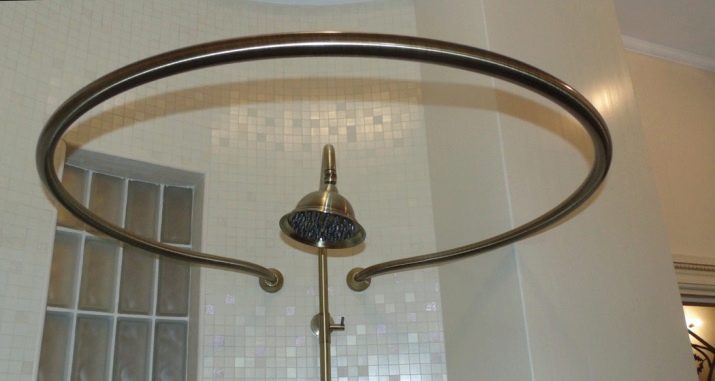
Here is an example of a semicircular cornice having two attachment points. There are no suspensions or supports, since the size and weight of the curtains allow you to use it without them. The stylistic design of the semicircular plank is also combined with the design decisions made when designing the decoration of the room. The chrome finish is in perfect harmony with the cool shades of the color design elements, as well as with the brilliant finish of the spotlight frames.
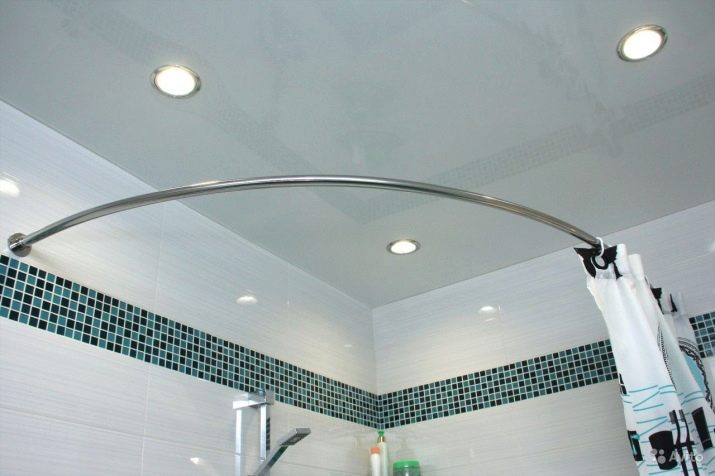
In this interior, an L-shaped cornice was used, which is due to the features of this room. Its coating is made in gilded variation. This is in harmony with the stylistic design of the curtains suspended on the bar. The individual character of the objects depicted in this photo reflects the general design mood of the entire room. Fixing rings also correspond to the profile of the angular rod, which allows them to move freely along it.
